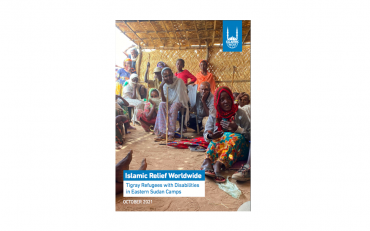“Too often invisible, too often forgotten, and too often overlooked, refugees with disabilities are among the most isolated, socially excluded and marginalized of all displaced populations,” Antonio Guterres, Secretary-General of the United Nations
When Guterres wrote this quote, more than a decade ago in research by the Women’s Refugee Commission, he went on to say that the barriers caused by ableism were the cause of great harm and exclusion.
This report, commissioned by Islamic Relief Worldwide in coordination with International Disability Alliance (IDA) will be in front of the Third Committee (Social, Humanitarian and Cultural) of the General Assembly today.
The report showcases the persistent exclusion of persons with disabilities from the humanitarian response, which further exacerbates the situation of refugees with disabilities, contributing to the violation of their rights. It is based upon field research in two refugee camps in Eastern Sudan, fleeing from the Tigray conflict.
“There are many problems in data collection, the staff often lacked disability awareness and technical expertise and knowledge to include information on refugees with disabilities, even when registering, refugees with disabilities said that they have not been asked about their needs, they have been asked about their health problems but nothing on their needs,” says Aaron, a refugee with disabilities. - A man with physical disability residing in Um Rakuba Camp East Sudan, March 2021
The findings presented in this report were identified through qualitative methods including a desk review, interviews and focus group discussions. The individual interviews were conducted by two persons with disabilities (who are also former participants of the IDA Bridge CRPD-SDGs Training Initiative). The interviews were done with organisations of persons with disabilities, humanitarian actors and international organisations along with an overview of the situation of refugees with disabilities. It identifies barriers to accessing support and makes practical recommendations to the governments, UN agencies, NGOs and INGOs working in similar refugee contexts.
The research reveals the challenges faced by refugees with disabilities, including non-identification during the refugee registration process, and a lack of access to mainstream assistance programs due to institutional, attitudinal, physical and informational, and communication barriers. Along with these barriers, they also can have barriers to getting food, access to healthcare, and to clean drinking Water, Sanitation, and Hygiene (WASH), among others.
The barriers faced by refugees with disabilities mean that they are less likely to be included in decision-making processes or in the appointment of camp leadership and management committees. There is no recognition of persons with disabilities’ potential to participate on an equal basis with others and they are considered as a recipient of aid rather than equal agents of change. Moreover, for those who fled Tigray alone without family members, the loss of family support caregivers exposes them to protection risks and exploitation.
Women, children, unaccompanied minors and older persons with disabilities face an even higher risk of being discriminated against or excluded from receiving appropriate support.
In general, as this research reveals, refugees with disabilities are among the most excluded of all displaced populations. Today, the UN Convention on the Rights of Persons with Disabilities (CRPD) together with International Humanitarian Law, such as the Inter-Agency Standing Committee (IASC) Guidelines on Inclusion of Persons with Disabilities in Humanitarian Action and UN Security Council Resolution 2475 along with other legal frameworks applicable to humanitarian settings, require all humanitarian assistance and protection efforts to be inclusive of persons with disabilities. The willingness to include persons with disabilities in humanitarian policies and frameworks should be accelerated.
Many humanitarian organisations have strengthened their policy frameworks to include and protect refugees with disabilities. However, facts and figures show that on the ground, much more needs to be done to ensure the rights of persons with disabilities.
Read the full report here.
